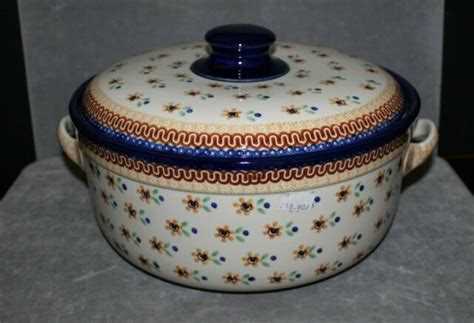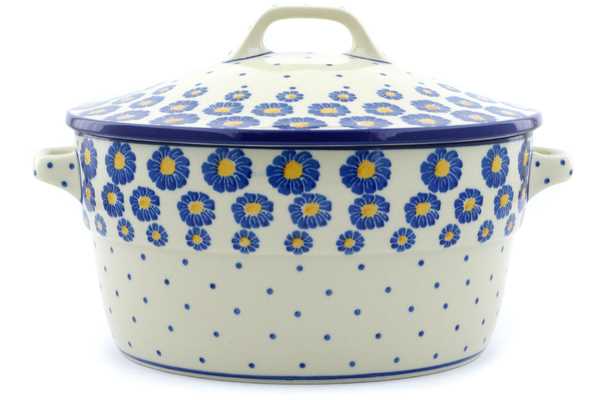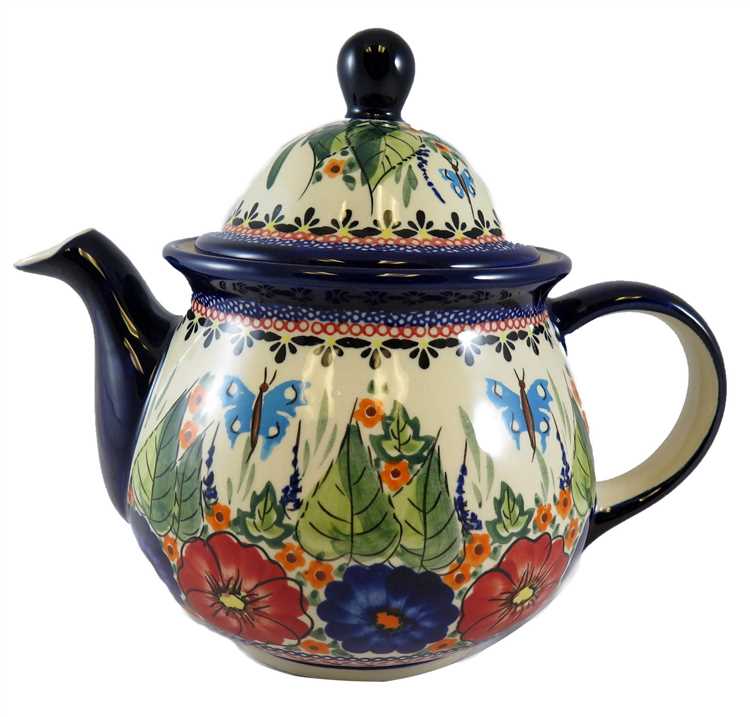Polish pottery is cherished for its unique and intricate designs, making it a popular choice for many kitchenware enthusiasts. But one question that often comes up is whether Polish pottery is oven safe. The answer is yes! Polish pottery is known for its exceptional heat resistance, making it safe to use in ovens.
Polish pottery is made using high-quality stoneware clay that is fired at very high temperatures, usually around 2000°F (1100°C). This firing process ensures that the pottery becomes extremely durable and can withstand the heat of an oven without cracking or breaking. Whether you’re baking a casserole, roasting meats, or making a delicious lasagna, you can confidently use your Polish pottery in the oven.
In addition to being oven safe, Polish pottery is also microwave and dishwasher safe. This makes it a versatile choice for everyday use in the kitchen. However, it’s important to note that sudden temperature changes can still cause the pottery to crack, so it’s recommended to let it cool down gradually after taking it out of the oven before exposing it to cold water or refrigeration.
With its beautiful designs and excellent heat resistance, Polish pottery is not only a functional addition to your kitchen but also a stylish one. So go ahead and create delicious meals with your favorite Polish pottery pieces, knowing that they are oven safe and will add a touch of elegance to your dining table.
What is Polish pottery?
Polish pottery, also known as Polish stoneware, is a type of ceramic ware that originated in the Bolesławiec region of Poland. It is renowned for its beautiful hand-painted designs and durable construction.
The history of Polish pottery dates back to the 14th century, when the first pottery workshops were established in Bolesławiec. The region is known for its rich clay deposits, which are ideal for making high-quality ceramics.
Polish pottery is made from a unique type of clay that is fired at extremely high temperatures. This process makes it highly resistant to chipping and cracking, making it durable and suitable for everyday use. The pottery is also glazed to give it a glossy finish and enhance its decorative patterns.
One of the distinguishing features of Polish pottery is its hand-painted designs. Skilled artisans meticulously paint intricate patterns onto the pottery using special brushes and techniques. These designs often feature floral motifs, geometric patterns, or traditional Polish folk art designs.
Polish pottery is not only prized for its beauty, but also for its functionality. It is oven safe, meaning it can be used for baking dishes and casseroles. It can also be used in the microwave, freezer, and dishwasher, making it versatile and easy to clean.
Today, Polish pottery is popular all over the world. It is often collected for its unique, whimsical designs and durability. Whether used for everyday dining or special occasions, Polish pottery adds a touch of elegance and charm to any table setting.
How is Polish pottery made?
Polish pottery, also known as Bolesławiec pottery, is made using a traditional handcrafted method that has been passed down through generations in the Bolesławiec region of Poland. The clay used to make Polish pottery is sourced from local mines and is known for its high quality and durability.
The process of making Polish pottery involves several steps:
- Gathering and preparing the clay: The clay is dug out from the mines and then cleaned, purified, and filtered to remove impurities. This ensures that the pottery will have a smooth and even texture.
- Shaping the pottery: The clay is then shaped into various forms using molds or by hand. Skilled artisans use their hands and simple tools to shape the clay into plates, bowls, mugs, and other pieces.
- Decorating the pottery: Once shaped, the pottery is carefully decorated using a special technique called stamping. Artisans use handmade stamps, often carved from potatoes, to create intricate patterns and designs on the pottery. The stamps are dipped in colored pottery slips and then pressed onto the clay to transfer the design.
- Firing the pottery: After the decorative process, the pottery is left to dry for several days. Once dry, it is fired in a kiln at high temperatures (around 1250 degrees Celsius) for several hours. This firing process makes the pottery hard and durable, as well as enhances the vibrant colors and patterns.
- Glazing the pottery: After the initial firing, the pottery is carefully dipped in a clear glaze. This glaze adds a glossy finish to the pottery and also acts as a protective layer.
- Second firing: The glazed pottery is then fired again at high temperatures to fuse the glaze onto the surface of the pottery. This second firing ensures that the glaze is durable and resistant to chipping or fading.
The entire process of making Polish pottery is labor-intensive and time-consuming. Each piece is handcrafted with attention to detail, resulting in unique and beautiful creations. Polish pottery is known for its distinctive blue and white patterns, but it also comes in a variety of other colors and designs. Whether it’s used for everyday dining or displayed as decorative pieces, Polish pottery adds a touch of elegance and charm to any home.
Is Polish Pottery Food Safe?
Polish pottery is not only known for its stunning designs and vibrant colors, but it is also popular for its food safety. The pottery is made from a unique type of clay called stoneware, which is known for its durability and resistance to heat.
Stoneware clay is fired at high temperatures, making it non-porous and ensuring that it does not absorb liquids or bacteria. This makes Polish pottery food safe and suitable for everyday use in the kitchen.
Polish pottery is also lead-free, which is an important factor in food safety. Lead is a toxic substance that can leach into food and cause serious health problems if consumed. The absence of lead in Polish pottery gives users peace of mind knowing that their food is not being contaminated.
In addition to being food safe, Polish pottery is also oven safe. It can be used in the oven at high temperatures without the risk of cracking or breaking. Whether you are baking casseroles, roasting meats, or broiling vegetables, Polish pottery is up to the task.
It is important to note that while Polish pottery is oven safe, it should not be used on stovetops or open flames. The high heat from these sources can cause the pottery to crack or even shatter.
If you are concerned about the safety of using Polish pottery in the microwave, rest assured that it is microwave safe as well. The stoneware clay used in Polish pottery is heat resistant and can withstand the high temperatures of the microwave without any issues.
When it comes to cleaning Polish pottery, it is recommended to hand wash it instead of using a dishwasher. While Polish pottery is dishwasher safe, hand washing will help to prolong its lifespan and keep it looking its best.
Overall, Polish pottery is not only beautiful but also safe to use with food. Its durability, heat resistance, and non-porous nature make it a great choice for serving, cooking, and baking. Whether you are hosting a dinner party or simply preparing a meal for your family, Polish pottery will add a touch of elegance to your table while ensuring the safety of your food.
Can Polish pottery be used in the oven?
Yes, Polish pottery is oven safe. It is specifically designed for use in ovens, microwaves, and dishwashers. Polish pottery is made from high-quality stoneware clay, which is fired at very high temperatures, typically around 1300 degrees Celsius. This firing process creates a durable and heat-resistant piece of pottery that can withstand oven temperatures.
When using Polish pottery in the oven, it is important to follow a few guidelines to ensure its longevity:
- Preheat the oven with the Polish pottery inside to prevent thermal shock.
- Avoid sudden changes in temperature, such as placing hot pottery directly into cold water or vice versa.
- Avoid placing frozen food or liquids directly into hot Polish pottery.
- Do not use Polish pottery on direct heat sources, such as stovetop burners or open flames.
- Use oven mitts or pot holders to handle hot Polish pottery.
It is important to note that while Polish pottery is oven safe, some patterns may be more susceptible to thermal shock than others. It is always recommended to check the manufacturer’s instructions or contact the seller to determine the specific oven safety of a particular piece of Polish pottery.
What temperature can Polish pottery withstand?
Polish pottery is known for its high quality and durability, and it is often used in ovens for baking and cooking. But what temperature can Polish pottery withstand?
Polish pottery is made from a special type of clay called stoneware, which is fired at very high temperatures. This makes it extremely resistant to heat and able to withstand high oven temperatures.
In general, Polish pottery can be safely used in ovens up to temperatures of 450 degrees Fahrenheit (232 degrees Celsius). This means you can bake, roast, and even broil your favorite dishes without worrying about damaging your Polish pottery.
However, it’s important to note that sudden changes in temperature can cause thermal shock and potentially crack or break your Polish pottery. To avoid this, it’s best to preheat your Polish pottery in the oven gradually, starting from a lower temperature and gradually increasing it to the desired temperature.
Additionally, it’s always a good idea to check the manufacturer’s guidelines and recommendations for your specific piece of Polish pottery. Some pieces may have specific temperature limitations or care instructions that you should follow to ensure the longevity of your pottery.
In conclusion, Polish pottery is oven-safe and can withstand high temperatures up to 450 degrees Fahrenheit. Just remember to preheat your pottery gradually and follow any specific instructions from the manufacturer to keep your pottery in the best condition possible.
Are there any restrictions for using Polish pottery in the oven?
Polish pottery is known for its beautiful and durable designs, but when it comes to using it in the oven, there are a few restrictions to keep in mind. While Polish pottery is generally oven-safe, there are some considerations to take into account to ensure its longevity and functionality.
Temperature restrictions:
Polish pottery is typically safe to use in the oven as long as the temperature does not exceed 350 degrees Fahrenheit (180 degrees Celsius). Higher temperatures can lead to cracking or discoloration of the pottery. It is important to refer to the specific manufacturer’s guidelines for the maximum temperature limit of a particular piece of Polish pottery.
Avoid sudden temperature changes:
Polish pottery should not be exposed to rapid changes in temperature. When placing Polish pottery in the oven, it is important to preheat the oven before inserting the pottery. Similarly, when removing the pottery from the oven, allow it to cool gradually to room temperature before exposing it to a colder environment, such as placing it on a cold countertop or in a refrigerator. Sudden temperature changes can cause the pottery to crack or break.
Avoid placing pottery on direct heat sources:
While Polish pottery is oven-safe, it is important to avoid placing it directly on top of a heat source, such as stovetop burners or grills. Direct heat can cause uneven heating and may lead to cracking or damage to the pottery. Instead, place the pottery on a baking sheet or rack to ensure even heat distribution.
Use caution with lids and handles:
When using Polish pottery in the oven, it is important to be cautious with lids and handles. Some pottery designs may have delicate or ornate handles and lids that may be more susceptible to damage at higher temperatures. It is recommended to check the manufacturer’s guidelines for specific instructions on using lids and handles in the oven.
Care and maintenance:
To ensure the longevity of your Polish pottery and to keep it in good condition, it is important to follow proper care and maintenance instructions. Avoid using abrasive materials when cleaning the pottery and instead opt for gentle, non-abrasive cleaners. Additionally, avoid using the pottery for storing or serving extremely hot or cold foods immediately after removing it from the oven to prevent thermal shock.
Conclusion:
Polish pottery is generally oven-safe, but it is important to be mindful of the temperature restrictions, avoid sudden temperature changes, avoid placing the pottery on direct heat sources, and exercise caution with lids and handles. By following these guidelines and properly caring for your Polish pottery, you can enjoy its beauty and functionality for years to come.
How to care for Polish pottery when using in the oven?
Polish pottery is known for its beautiful hand-painted designs and durability. It can be used not only for serving and display purposes but also in the oven. Here are some tips on how to care for your Polish pottery when using it in the oven:
- Preheat the oven: Before placing your Polish pottery in the oven, it’s important to preheat the oven to the desired temperature. This helps to ensure even cooking and prevent any sudden temperature changes that could cause the pottery to crack.
- Avoid extreme temperature changes: While Polish pottery is oven-safe, it’s important to avoid exposing it to extreme temperature changes. For example, do not take a cold dish directly from the refrigerator and place it in a hot oven, as it can cause thermal shock and lead to cracking.
- Avoid direct contact with heat source: When placing Polish pottery in the oven, it’s best to avoid direct contact with the heat source. You can use a baking sheet or dish towel as a barrier between the pottery and the oven rack or heating element.
- Avoid sudden temperature changes: When removing Polish pottery from the oven, it’s important to avoid sudden temperature changes as well. Place the hot dish on a trivet or a heat-resistant surface instead of a cold countertop or sink.
- Hand wash after use: To clean your Polish pottery after using it in the oven, it’s best to hand wash it with warm water and a mild dish soap. Avoid using abrasive scrub brushes or harsh cleaning chemicals, as they can damage the beautiful designs.
- Avoid drastic temperature changes when cleaning: When washing your Polish pottery, avoid exposing it to drastic temperature changes. Let it cool down naturally before washing it with warm water to prevent thermal shock and potential cracking.
- Avoid stacking hot pottery: After removing Polish pottery from the oven, it’s important to avoid stacking hot dishes. Allow them to cool down completely before stacking them to prevent any potential damage.
By following these tips, you can ensure that your Polish pottery remains in excellent condition even when used in the oven. Enjoy cooking and serving your favorite dishes in these beautiful and functional pieces!
Where to buy oven-safe Polish pottery?
If you are looking to buy oven-safe Polish pottery, there are several options available to you. Here are some places where you can find a wide selection of oven-safe Polish pottery:
- Directly from the manufacturer: Many Polish pottery manufacturers have their own online shops where you can purchase their products. This ensures that you are buying authentic Polish pottery that is oven-safe and of high quality.
- Specialty Polish pottery stores: There are specialty stores that focus on selling Polish pottery. These stores often have a wide selection of oven-safe Polish pottery from different manufacturers.
- Online marketplaces: You can also find oven-safe Polish pottery on online marketplaces such as Amazon, Etsy, or eBay. These platforms usually have a wide range of options available and allow you to compare prices and read customer reviews.
- Polish markets and festivals: If you have access to Polish markets or festivals, you may be able to find oven-safe Polish pottery there. These events often feature artisans and vendors selling various Polish products, including pottery.
When buying oven-safe Polish pottery, it is important to pay attention to the product descriptions and specifications. Look for information about the maximum safe temperature for oven use, as well as any specific care instructions. Additionally, consider the design, size, and price of the pottery to ensure that it meets your needs and preferences.
By purchasing oven-safe Polish pottery from reputable sources, you can enjoy the beautiful designs and functional nature of this traditional Polish art form while also ensuring that it is safe to use in your oven.
FAQ:
Is Polish pottery oven safe?
Yes, Polish pottery is oven safe. It can withstand high temperatures and is designed to be used in ovens.
Can I use Polish pottery in the microwave?
No, Polish pottery is not recommended for use in the microwave as it may get too hot and cause the pottery to crack or break.
What temperature can Polish pottery withstand in the oven?
Polish pottery can withstand temperatures up to 480 degrees Fahrenheit in the oven, making it suitable for most baking and cooking needs.
Can I put hot Polish pottery directly on a cold surface?
No, it is not recommended to put hot Polish pottery directly on a cold surface as it may cause thermal shock and lead to cracking or breaking of the pottery.
Is Polish pottery dishwasher safe?
Yes, Polish pottery is dishwasher safe. It is recommended to place the pottery on the top rack of the dishwasher to avoid any potential damage.
How should I care for my Polish pottery?
To care for your Polish pottery, it is best to hand wash it with warm soapy water. Avoid using abrasive sponges or cleaners, as they may scratch the surface. Store the pottery in a dry and cool place to prevent any potential damage.


